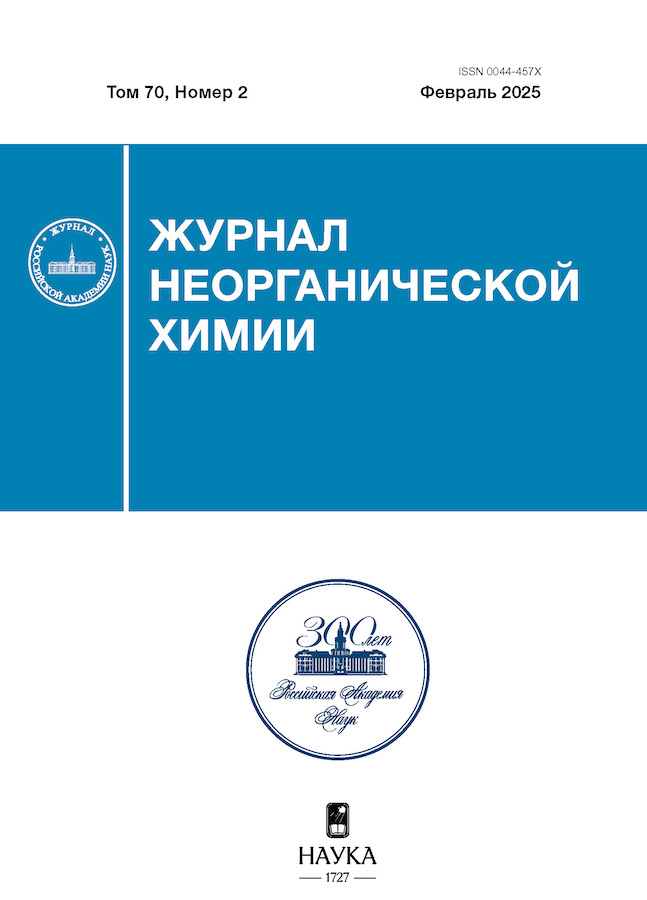Features of the synthesis of magnesium praseodymium hexaaluminate PrMgAl11O19 with a magnetoplumbite structure
- Authors: Ryumin М.А.1, Nikiforova G.Е.1, Gagarin P.G.1, Kondrat’eva O.N.1, Gavrcihev K.S.1
-
Affiliations:
- Kurnakov Institute of General and Inorganic Chemistry of RAS
- Issue: Vol 70, No 2 (2025)
- Pages: 172-180
- Section: СИНТЕЗ И СВОЙСТВА НЕОРГАНИЧЕСКИХ СОЕДИНЕНИЙ
- URL: https://kazanmedjournal.ru/0044-457X/article/view/683195
- DOI: https://doi.org/10.31857/S0044457X25020043
- EDN: https://elibrary.ru/IDCTMB
- ID: 683195
Cite item
Abstract
RE magnesium hexaaluminates with magnetoplumbite structure are considered as potential candidates for thermal barrier coatings. However, the synthesis of single-phase samples is associated with certain difficulties. In this work, the features of PrMgAl11O19 preparation by reverse precipitation and citrate sol-gel synthesis are compared. Based on the results of thermal analysis of precursors, stepwise annealing of the samples was carried out, followed by X-ray phase analysis of the product. It is shown that the optimal condition for producing single-phase hexaaluminate PrMgAl11O19 is long-term annealing of tableted precursors obtained by the sol-gel method at a temperature of 1600°C. Thermodynamic assessment of possible reactions of praseodymium magnesium hexaaluminate formation from oxides confirmed the decomposition of PrMgAl11O19 at temperatures above 1700°C.
Keywords
Full Text
About the authors
М. А. Ryumin
Kurnakov Institute of General and Inorganic Chemistry of RAS
Email: gagarin@igic.ras.ru
Russian Federation, Moscow, 119991
G. Е. Nikiforova
Kurnakov Institute of General and Inorganic Chemistry of RAS
Email: gagarin@igic.ras.ru
Russian Federation, Moscow, 119991
P. G. Gagarin
Kurnakov Institute of General and Inorganic Chemistry of RAS
Author for correspondence.
Email: gagarin@igic.ras.ru
Russian Federation, Moscow, 119991
O. N. Kondrat’eva
Kurnakov Institute of General and Inorganic Chemistry of RAS
Email: gagarin@igic.ras.ru
Russian Federation, Moscow, 119991
K. S. Gavrcihev
Kurnakov Institute of General and Inorganic Chemistry of RAS
Email: gagarin@igic.ras.ru
Russian Federation, Moscow, 119991
References
- Padture N.P., Gell M., Jordan E.H. // Science. 2002. V. 296. № 5566. P. 280. https://doi.org/10.1126/science.1068609
- Xueqiang C.A.O. // J. Mater. Sci. Technol. 2007. V. 23. № 1. P. 15. https://www.jmst.org/EN/Y2007/V23/I01/15
- Clarke D.R., Phillpot S.R. // Mater. Today. 2005. V. 8. № 6. P. 22. https://doi.org/10.1016/S1369-7021(05)70934-2
- Gleeson B. // J. Propulsion Power. 2006 V. 22. № 23. P. 75. https://doi.org/10.2514/1.20734
- Seraffon M., Simms N.J., Sumner J. et al. // Surf. Coat. Technol. 2011. V. 206. № 7. P. 1529. https://doi.org/10.1016/j.surfcoat.2011.06.023
- Vassen R., Cao X., Tietz F. et al. // J. Am. Ceram. Soc. 2000. V. 83. № 8. P. 2023. https://doi.org/10.1111/j.1151-2916.2000.tb01506.x
- Drexler J.M., Gledhill A.D., Shinoda K. et al. // Adv. Mater. 2011. V. 23. № 21. P. 2419. https://doi.org/10.1002/adma.201004783
- Ma W., Mack D.E., Vaßen R. et al. // J. Am. Ceram. Soc. 2008. V. 91. № 8. P. 2630. https://doi.org/10.1111/j.1551-2916.2008.02472.x
- Bansal N.P., Zhu D.M. // Surf. Coat. Technol. 2008. V. 202. № 12. P. 2698. https://doi.org/10.1016/j.surfcoat.2007.09.048
- Choi S.R., Bansal N.P., Zhu D.M. // Ceram. Eng. Sci. Proc. 2005. V. 26. P. 11. https://doi.org/10.1002/9780470291238.ch2
- Haoran L., Chang-An W., Chenguang Zh. et al. // J. Eur. Ceram. Soc. 2015. V. 35. № 4. P. 1297. https://doi.org/10.1016/j.jeurceramsoc.2014.10.030
- Li X., Deng Z., Zhao H. et al. // Surf. Coat. Technol. 2022. V. 440. P. 128490. https://doi.org/10.1016/j.surfcoat.2022.128490
- Wang Y.H., Ouyang J.H., Liu Z.G. // J. Alloys Compd. 2009. V. 485. P. 734. https://doi.org/10.1016/j.jallcom.2009.06.068
- Chen X., Sun Y., Hu J. et al. // J. Eur. Ceram. Soc. 2020. V. 40. № 4. P. 1424. https://doi.org/10.1016/j.jeurceramsoc.2019.12.039
- Min X., Fang M., Huang Z. et al. // Mater. Lett. 2014. V. 125. P. 140. https://doi.org/10.1016/j.matlet.2014.03.171
- Min X., Fang M., Huang Z. et al. // J. Am. Ceram. Soc. 2015. V. 98. № 3. P. 788. https://doi.org/10.1111/jace.13346
- Tian M., Wang X.D., Zhang T. // Catal. Sci. Technol. 2016. V. 6. № 7. P. 1984. https://doi.org/10.1039/C5CY02077H
- Sun J., Wang J., Hui Y. et al. // Ceram. Int. 2020. V. 46. № 4. P. 4174. https://doi.org/10.1016/j.ceramint.2019.10.135
- Wang Y.H., Ouyang J.H., Liu Z.G. // Mater. Design. 2010. V. 31. № 7. P. 3353. https://doi.org/10.1016/j.matdes.2010.01.058
- Wang C.A., Lu H., Huang Z. et al. // J. Am. Ceram. Soc. 2018. V. 101. № 3. P. 1095. https://doi.org/10.1111/jace.15285
- Bhattacharya I.N., Das S.C., Mukherjee P.S. et al. // Scand. J. Metall. 2004. V. 33. № 4. P. 211. https://doi.org/10.1111/j.1600-0692.2004.00686.x
- Sokovnin S.Y., Il’ves V.G. // Nanotechnologies Russ. 2013. V. 8. № 3. P. 220. https://doi.org/10.1134/S1995078013020171
- Gagarin P.G., Guskov A.V., Guskov V.N. // Russ. J. Inorg. Chem. 2023. V. 68. № 11. P. 1599. https://doi.org/10.31857/S0044457X23601062 [Гагарин П.Г., Гуськов А.В., Гуськов В.Н. и др. // Журн. неорган. химии. 2023. Т. 68. № 11. С. 1607.]
- Kahn A., Lejus A.M., Madsac M. et al. // J. Appl. Phys. 1981. V. 52. № 11. P. 6864. https://doi.org/10.1063/1.328680
- Ma Z., Zheng S., Chen Y. et al. // Phys. Rev. B. 2024. V. 109. № 16. P. 165143. https://doi.org/10.1103/physrevb.109.165143
- Cao Y., Bu H., Fu Z. et al. // Mater. Futures. 2024. V. 3. № 3. P. 035201. https://doi.org/10.1088/2752-5724/ad4a93
- Zhu R.X., Liu Z.G., Ouyang J.H. et al. // Ceram. Int. 2013. V. 39. № 8. P. 8841. https://doi.org/10.1016/j.ceramint.2013.04.073
- Robie R.A., Hemingway B.S., Fisher J.R. // US Geol. Surv. Bull. 1978. № 1452. P. 364. https://doi.org/10.1021/cm201964r
- Gruber J.B., Justice B.H., Westrum Jr E.F. et al. // J. Chem. Thermodyn. 2002. V. 34. № 4. P. 457. https://doi.org/10.1006/jcht.2001.0860
- Zhang Y., Navrotsky A. // J. Non-Cryst. Solids. 2004. V. 341. P. 141. https://doi.org/10.1016/j.jnoncrysol.2004.04.027.
- Tachibana M., Fritsch K., Gaulin B.D. // Phys. Rev. B: Condens. Matter Mater. Phys. 2014. V. 89. № 17. P. 174106. https://doi.org/10.1103/PhysRevB.89.174106.
- Glasser L. // Chem. Thermodyn. Therm. Anal. 2022. V. 7. P. 100069. https://doi.org/10.1016/j.ctta.2022.100069
- Gagarin P.G., Guskov A.V., Guskov V.N. et al. // Russ. J. Inorg. Chem. 2024. Т. 69. № 10. P. 1532. https://10.1134/S0036023624602186 [Гагарин П.Г., Гуськов А.В., Гуськов В.Н. и др. // Журн. неорган. химии. 2024. Т. 69. № 10. С. 1424. https://doi.org/10.31857/S0044457X24100081 ]
Supplementary files

















